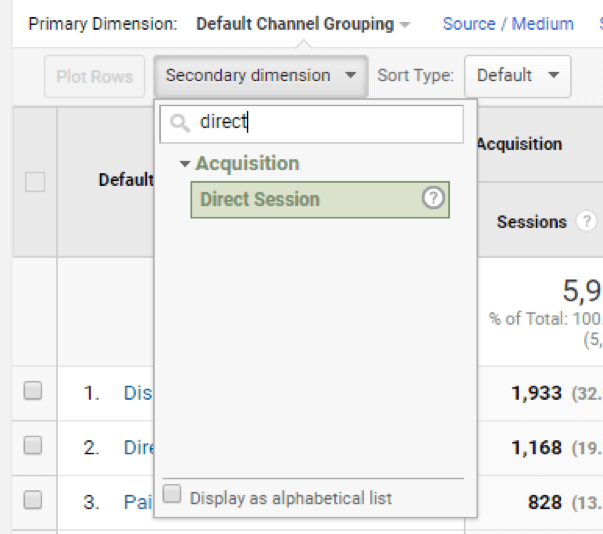Optimizing SEO with Secondary Dimension in Google Analytics
Wiki Article
Transform Your Analytics Strategy With Secondary Measurement in Google Analytics
By incorporating secondary measurements right into data evaluation, a new layer of insights arises, losing light on complex user actions and interactions. The tactical application of secondary measurements holds the key to opening a treasure trove of very useful details that can change just how services act and translate upon their data.Recognizing Second Dimensions in Google Analytics
Additional measurements in Google Analytics give extra context to main information by allowing users to examine metrics across a second measurement, offering deeper understandings right into user habits and interactions on a web site. Secondary Dimension in Google Analytics. While key dimensions supply fundamental information points such as pageviews, bounce rate, and session duration, secondary dimensions supply a more comprehensive sight by segmenting the primary data additionally. This division enables users to evaluate metrics in mix with one more measurement, such as website traffic resources, demographics, or individual behaviorBenefits of Making Use Of Second Measurements
Making use of additional dimensions in Google Analytics supplies a strategic advantage by enhancing the deepness of evaluation and supplying a much more thorough understanding of customer communications and actions on a web site. By incorporating additional measurements, analysts can gain important insights into the efficiency of particular sections or variables within their information. This makes it possible for an extra thorough examination of user actions past surface-level metrics, allowing for a much deeper expedition of the elements affecting customer interaction and conversions.
How to Execute Second Measurements
When including secondary dimensions in Google Analytics, one vital step is to choose the appropriate metrics and measurements to enrich the analysis procedure. Clicking on this switch will certainly open up a drop-down menu listing various measurements that can be included to your key measurement for much deeper understandings.After choosing the proper second dimension, such as 'Source/Medium' or 'Tool Category,' Google Analytics will show the data in a much more detailed format, allowing you to cross-analyze various aspects of individual behavior. Remember to explore different combinations of primary and secondary dimensions to reveal important patterns and trends that can educate your advertising and marketing methods. By executing secondary measurements attentively, you can obtain a more detailed understanding of your website or app performance and make data-driven decisions to enhance your electronic visibility.
Analyzing Data With Additional Measurements
Improve your information analysis in Google Analytics by integrating additional measurements to dig much deeper into user habits patterns and optimize your digital advertising and marketing methods properly - Secondary Dimension in Google Analytics. By including additional dimensions to your primary data, you can get useful insights that can aid you make educated decisions about your Recommended Reading web site or application efficiency
Evaluating data with secondary dimensions permits you to sector your primary data better, offering a much more extensive sight of user communications. Combining the main measurement of 'source/medium' with a secondary measurement like 'touchdown page' can disclose which specific web pages are driving website traffic from various sources. This information can be instrumental in refining your content method or enhancing your advertising and marketing campaigns to boost conversions.
Furthermore, making use of secondary dimensions enables you to identify correlations between various metrics, aiding you understand the impact of different aspects on user actions. Whether it's assessing demographics alongside customer interaction metrics or gadget categories with conversion prices, second measurements encourage you to uncover concealed patterns and patterns that can guide your advertising and marketing efforts.
Optimizing Performance With Second Measurements
To improve the efficiency of data evaluation and decision-making in Google Analytics, incorporating secondary dimensions is essential to enhancing performance metrics and acquiring much deeper insights right i thought about this into user actions patterns. By making use of additional dimensions, analysts can dive beyond surface-level information and reveal beneficial relationships that might otherwise go undetected. This optimization approach allows organizations to customize their advertising and marketing efforts better, determine areas for improvement in website use, and enhance general customer experience.Secondary dimensions offer a more detailed sight of customer interactions by giving extra context to primary data metrics. Pairing the key measurement of 'touchdown page' with an additional measurement like 'tool classification' can reveal whether certain tools are extra most likely to drive engagement on particular landing pages. This understanding can notify receptive style renovations or targeted marketing methods to enhance performance.

Final Thought
Finally, the combination of additional dimensions in Google Analytics gives organizations with an effective tool to improve their analytics approach. Secondary Dimension in Google Analytics. By delving deeper right into user habits and communications, marketers can reveal beneficial insights that can drive efficiency optimization and boost the general user experience. Leveraging secondary measurements allows for a more detailed analysis of information, causing even more enlightened decision-making and customized advertising initiativesAdditional measurements in Google Analytics offer extra context to key information by permitting users to assess metrics across a wikipedia reference second dimension, using much deeper understandings right into individual behavior and communications on an internet site. While primary measurements provide essential information factors such as pageviews, bounce price, and session period, second measurements offer a more detailed view by segmenting the primary data even more.One of the vital advantages of using additional measurements is the capacity to reveal relationships and patterns that may not be instantly obvious when evaluating data with key dimensions alone.When incorporating additional dimensions in Google Analytics, one necessary action is to select the relevant metrics and measurements to enrich the evaluation process. Combining the primary dimension of 'touchdown page' with an additional measurement like 'device classification' can reveal whether particular gadgets are more most likely to drive engagement on particular touchdown pages.
Report this wiki page